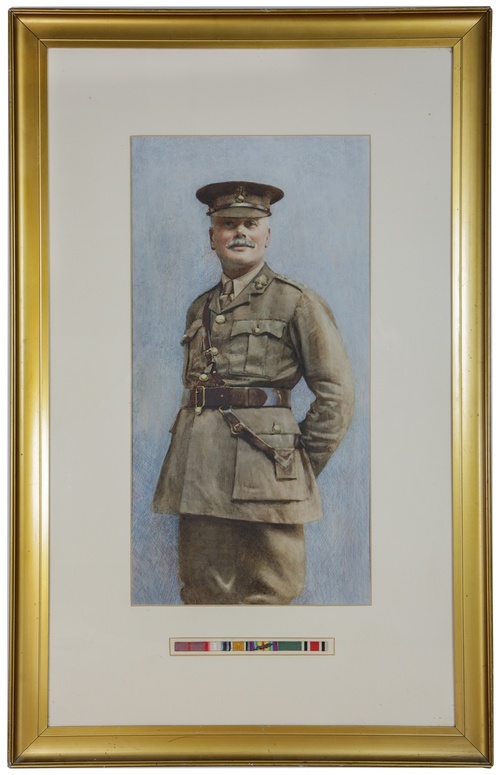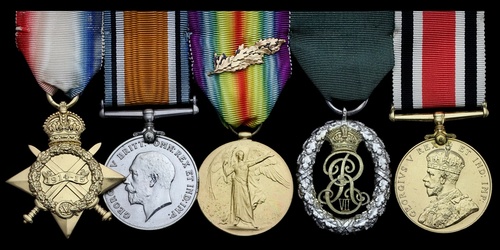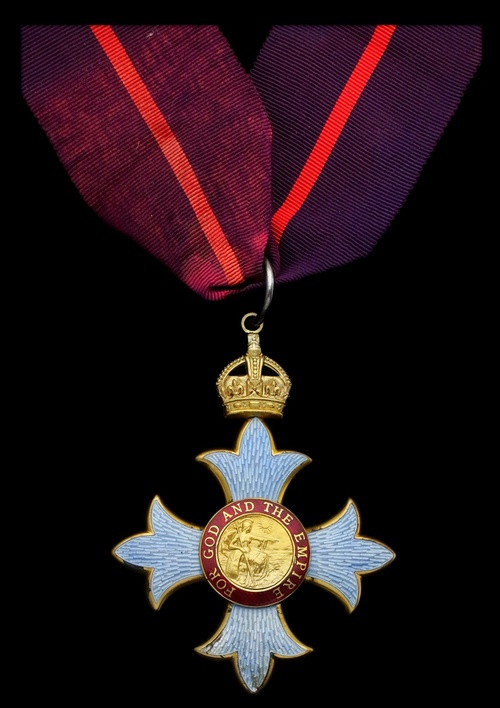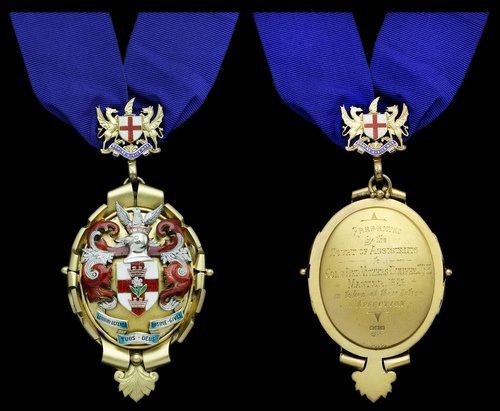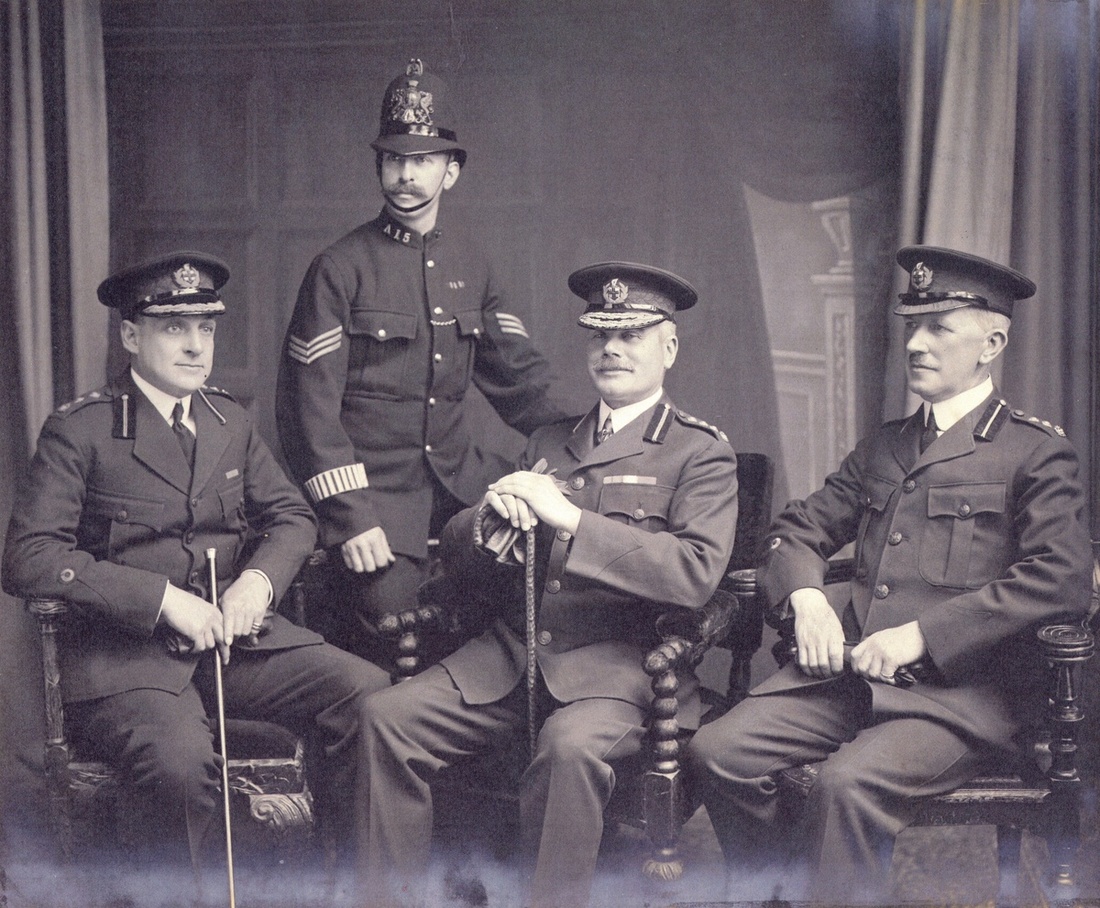Auction: 20001 - Orders, Decorations and Medals - conducted behind closed doors
Lot: 650
An extremely fine Great War C.B.E. group of seven awarded to Lieutenant-Colonel V. Dunfee, CO of the 2/4th London Regiment at Gallipoli and during the Senussi campaign, who served as the first Commandant of the City of London Police Reserve from 1911-1914, and later returned to serve a further nine years from 1918-1927; besides this he arranged the Great War Peace Parade in the City of London
The Most Excellent Order of the British Empire, C.B.E. (Military) Commander's 1st type neck badge complete with neck riband; 1914-15 Star (Lt. Col. V. Dunfee. 4/Lond. R.); British War and Victory Medals, with M.I.D. oak leaves (Lt. Col. V. Dunfee.); Volunteer Officer's Decoration, E.VII.R., the reverse with hallmarks for London 1903; Special Constabulary Long Service, G.V.R., 1st issue (Col. Vickers Dunfee. C.B.E., V.D.), mounted as worn where applicable, together with City of London Jewel, silver-gilt and enamel, 115mm x 57mm, reverse engraved 'Presented by the Court of Assistants to Col. & Dep. Vickers Dunfee C.B.E. Master. 1926. In token of their Esteem & Affection.', hallmarks for Birmingham 1926, good very fine, housed in a fitted glazed frame (7)
C.B.E. London Gazette 3 June 1919.
Vickers Dunfee was born on 30 April 1861 at Hanover Square, London, the son of William Dunfee of 28 Queen Street, St. Leonards-on-Sea, Hastings, East Sussex. Educated at King's College School, he entered his father's business of William Dunfee & Co., wine and spirit merchants, before being appointed to a temporary commission on 6 September 1884 as Lieutenant in the 1st Battalion, Tower Hamlets Rifle Volunteers. Witnessing steady promotion through the ranks, he was granted the Honorary rank of Colonel on 5 September 1903 and was awarded the Volunteer Decoration on 15 November 1904. Transferred to the 4th Volunteer Battalion, City of London Regiment, he retired on 1 November 1908 and likely put his energies into helping his wife Caroline raise their four sons. He also served from 1911-14 as the first Commandant of the City of London Police Reserve, organising the recruitment of 2000 Special Constables at a time of considerable national uncertainty.
Recalled to the Colours at the outbreak of the Great War, Dunfee was appointed Lieutenant Colonel on 6 September 1914 and placed in command of the newly-formed 2/4th Battalion, The London Regiment. Within two weeks of formation, the 2/4th numbered a strength of over 400 men which necessitated a move from Hoxton to New Barnet on 23 September 1914 for training. By 14 December it had grown under Dunfee to 27 officers and 986 other ranks, and joined the rest of 2/1st London Brigade at Maidstone. Ordered to Southampton, the 2/4th Battalion embarked aboard H.M.T. Avon on 23 December 1914 bound for Malta, arriving a little over a week later on 2 January 1915. Here they continued with their training, conducted public duties and guarded prisoners of war, before being transferred to Egypt aboard Southlands on 21 August 1915 and on to Gallipoli.
Serving on the peninsula from September 1915, Dunfee led the 2/4th London Battalion during their introduction to trench warfare in the 'Eski' reserve line from 20-27 October 1915, suffering their first battle casualties. Thereafter, his men conducted seven-day tours of duty in the reserve line, alternating with 'rest' in the flooded camps to the rear. In December the men returned to the front line trenches where harsh weather, disease and Turkish attacks began to have a significantly detrimental effect on troop numbers and morale. On 5 December 1915 Dunfee left his unit bound for Mudros aboard the Olympic. Stating the need to return home for 'urgent private affairs', he was reluctantly granted a month's leave, his private record noting the inconvenience of losing a commanding officer at such a critical time.
Returning to his Battalion in Egypt, Dunfee likely joined the force at Minia which guarded the Nile against a potential attack by Senussi rebels. He subsequently commanded a force at Beni Mazar, guarding the strategically important railway line with detachments of Lovat's Scouts, the Australian Light Horse, a number of Royal Engineers and an armoured train. On 4 February 1916, whilst still at Beni Mazar, Dunfee applied for leave to return to England. This was granted, but on the return voyage to Egypt the Director of Personnel Services appeared less than impressed with the Lieutenant-Colonel, who had requested an 'indulgent passage' to Egypt:
'There are no transports in view, and it is very doubtful if indulgence passage can be granted.'
Transferred to France, Dunfee was mentioned in despatches (London Gazette 13 July 1916, refers), and likely witnessed the heavy fighting at Bullecourt, Ypres and during the German Spring Offensive. At the cessation of hostilities he returned home and organised the triumphal 'Peace Parade' march through the City and Westminster involving 15,000 men from the City and County of London units (City of London Special Constabulary 1911-2011, refers). He was awarded the C.B.E. (Military Division) in June 1919.
Taking back the reins of the City of London Police from Colonel J. W. Benningfield, O.B.E., V.D., C.C., Dunfee became one of His Majesty's Lieutenants for the City, an active member of the City of London Territorial Association and a Magistrate for the County of London. His premature death from illness on 17 February 1927 resulted in the Corporation of the City of London losing one of its oldest and most admired members; a representative of the Vintry Ward since 1893 and Deputy Alderman in 1914, his loss was keenly felt. By the end of the year the Vickers Dunfee Memorial Fund - a memorial to the Commandant - for the relief of distressed past and present Constables, had £3779 8s. 6d. raised by public subscription.
Leaving effects totalling £15,280 11s. in his will, equivalent to approximately £1 million today (The Bank of England inflation calculator, refers), Dunfee's sons were able to indulge in a love of speed, particularly motor racing. As two of the wealthy 'Bentley Boys', Jack and Clive Dunfee became racing drivers during a Golden Era in Motor Racing. Clive was killed in a dramatic accident at Brooklands in 1932 during the British Racing Driver's Championship 500 mile race; in passing Earl Howe's Bugatti, he put the wheel of his machine over the lip of the banking causing his Bentley to cartwheel over the top and plunge into trees. He was killed outright. A second brother, Flight Lieutenant Geoffrey Edgar Dunfee, R.A.F.V.R., died whilst serving as a Mosquito Pilot with No. 125 Squadron during the Second World War. It is believed that his aeroplane crashed into the English Channel off the Port of Dover on return from a 'rhubarb' in August 1944.
Sold with copied MIC and service record, extensive research and the following original items and ephemera:
(i)
Two large and particularly fine leather-bound scrapbooks, containing hundreds of newspaper cuttings relating to officers and men of the London Regiment, particularly those awarded decorations or killed in action.
The First book commences with his original Certificate of Attestation to the 4th Battalion, Royal Fusilers, dated 20 August 1883. It includes an outstanding archive of family photographs, letters to Dunfee written in the final years of the Great War, invitations to military and civil ceremonies, original Lord Mayor and Stationers' Hall dinner menus, correspondence from the City of London Police Reserve and some outstanding large parade photographs relating to the Inspection by H.M. The King at Hyde Park on 19 July 1919 and the Victory March a few days earlier. This is followed by a congratulatory letter on Windsor Castle headed notepaper, offering Dunfee the King's appreciation of the public-spirited service displayed by the City of London Police Reserve. The last few pages of the album are filled with his original City of London 'For Services Rendered 1914-1919' Certificate, and a delightful group photograph of Dunfee with colleagues from the City of London Police Reserve. In average exterior condition, spine lacking leather binding, the interior pages considerably better.
The Second book commences with a Certificate to Dunfee from the Epping Forest Committee. It includes photographs of formal dinners involving men of the City of London Police Reserve and a poignant large photograph of the Armistice Day Memorial Service held at the Royal Exchange on 11 November 1923. It continues with a large number of newspaper cuttings and a rather splendid menu from the First Annual Dinner of the City of London Police Detective Department, conducted at Hamilton Hall on 28 November, 1924. It concludes with cuttings relating to the early motoring escapades of his sons and contemporary racing drivers. The outer cover separate from the binding, all pages neatly and firmly held together, and in generally good condition.
(ii)
An attractive large bronze medallion, bearing the busts of the Duke and Duchess of York, held within a fitted case of issue, the front cover reading in gilt lettering 'In Commemoration of the Raising and Equipment of The City of London Imperial Volunteers, and their service in South Africa 1899-1900. The Right Hon. Sir Alfred James Newton, Bart. Lord Mayor', the medallion unnamed as issued and in good condition, the case damaged and worn.
(iii)
A large framed City of London Police Reserve Cerificate, awarded to Sergeant W. B. Stevenson in recognition of Valuable Services, dated 19 August 1914, bearing the original signature of Vickers Dunfee, in contemporary glazed wooded frame, this damaged to one corner, otherwise in fair condition.
(iv)
A collection of contemporary hardback books relating to the career and life of Lieutenant Colonel Dunfee, including; History of the Old 2/4th Battalion (City of London); London's Roll of Fame 1757-1884; The Tower Hamlets Rifle Volunteer Brigade; History of the Worshipful Company of Plumbers; Visit to Prague. Together with a number of modern hardback and paperback books, including City of London Special Constabulary 1911-2011; Peace Year in the City 1918-1919; Badges and Medals of the Livery Companies of the City of London; History of the Worshipful Company of Fruiterers of the City of London; The Guild of Freemen of The City of London and Diver! Diver! Diver!, these contained in a period suitcase, in good condition throughout.
(v)
A particularly fine full-length pastel and mixed-media portrait of the recipient in military uniform, unsigned, mounted in a gold frame behind glass, with contemporary riband bar, frame approximately 650 x 1000mm, in good condition.
Subject to 20% VAT on Buyer’s Premium. For more information please view Terms and Conditions for Buyers.
Sold for
£1,800
Starting price
£1800

